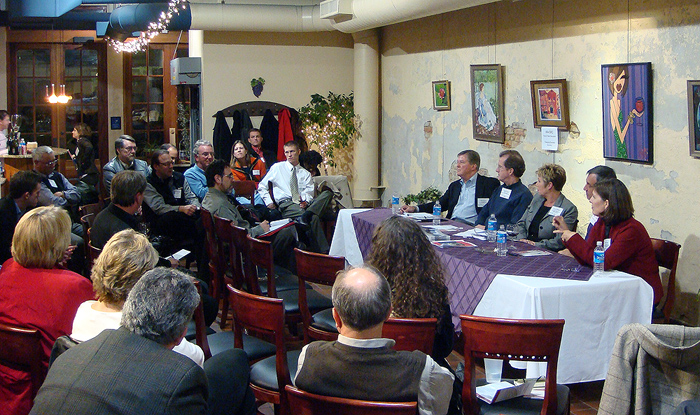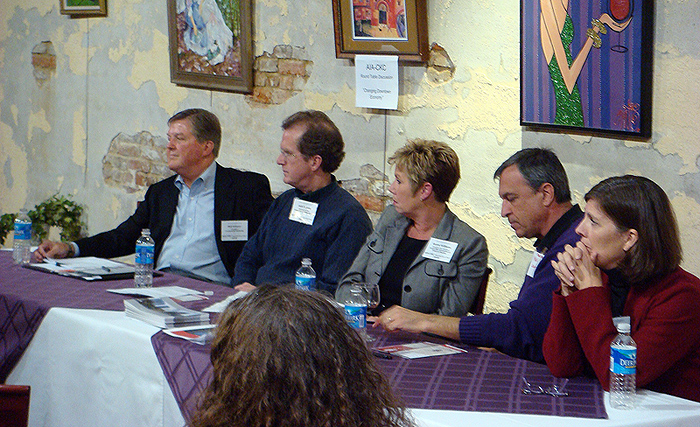Last night, local architects gathered to hear five business and government leaders discuss the future of Louisville’s “Changing Downtown Economy” at Felice Vineyards on East Market Street. The group tackled issues surrounding downtown development, the economic crisis, and convention tourism.
Opening remarks began on a cheerful tone from the self-proclaimed “Downtown Cheerleader” Patti Clare, Interim Director of the Downtown Development Corporation, but progressed to a more somber and sometimes outright bleak outlook towards the end. Â The discussions grew heated over some issues as panelists clashed on the realities surrounding development and economy today in Louisville.
Patti Clare noted how much progress has been made in the 20 years she has been involved with downtown development. She remembers as massive projects came and went with little lasting impact and how in recent years confidence in downtown had been lukewarm at best. She has been delighted over the last couple of years as “downtown has seen a spark” and become a “hot” market with momentum and confidence building in many recently announced projects.
The credit crisis changed all this and she warned that Louisville “cannot fall prey to tentativeness” and become fearful of downtown investment. While there has been a drastic reduction in new housing permits across the board, she is heartened that there has been no decrease in renovation permits since 2007.
While hopeful large projects like Museum Plaza or Iron Quarter will one day make it through, she realizes that small projects (like the Marcus Lindsey Church condos, Whiskey Row Lofts, and Bycks Lofts) will carry downtown through to better times. Mega-projects are inherently more complicated and take more time.
Karen Williams, the Exec. VP of the Louisville Convention & Visitors Bureau, also spoke about the progress she has seen in downtown as the convention business has grown with the expansion of the convention center, construction of new hotels like the Marriott, and renovations at the Galt House. While we lag behind other cities in terms of hotel rooms, we are a leader in convention space.
She explained how the arena will strengthen Louisville’s appeal even more. Now that the project has moved out of the planning room and has begun moving dirt, she says interest from groups is beginning to take off and events have been signed for as far out as 2025. Williams adopts a “you can’t lose what you don’t have” strategy to the convention business noting the Louisville market has always been strong with professional associations, but lacked corporate events which are hurting most in this economy.
Jack Trawick, Director of the Center for Neighborhoods, shifted the conversation to housing. He expressed the need for people to live in the central urban area and noted that downtown housing cannot be a slogan or just an idea thrown out by the city. It requires real risk and actual investment from the city and private interests.
Phil Scherer, President of Commercial Kentucky, picked up on the topic using his experience developing the Billy Goat Strut, Preston Pointe, and Fleur-de-Lis on Main to show change in Louisville. The city has come a long way since he began downtown development in the 1980s. Back then, he quipped, the city reassured him they were right behind him on development, but he didn’t realize then just how far behind. His insights into the local economy left the crowd feeling sobered, but not completely depressed (quite a feat considering how much Felice wine was being consumed).
He believes in not exaggerating downtown progress. He explained that there are less than 100 downtown condos for sale, but as recently as the Ryder Cup, the mayor was bragging the city had 2,000 new units downtown. Scherer worries that over-stating figures like this puts the community in a comfort zone where they believe development is where it should be. It can result in a development slowdown. He also sees many of the mega-projects regaining a footing in years to come, noting that a new Humana tower, though probably delayed in the short term, could potentially begin in 2011 or 2012.
Mark Isaacs, President of Legacy Homes and developer of the Legacy Lofts, feared he couldn’t paint such a rosy picture. He explained how he believes Louisville has the potential to join the ranks of great urban cities, but currently must come to terms with its place as a tertiary market, not the secondary market we all believe ourselves in, or the primary market we aspire to be.
He noted that for downtown housing, in Louisville, a developer is extremely lucky to sell one unit per month per project, a dismally low sales rate for any progress on the housing front. The reality is sales are even lower than that. He feels that currently, despite the economic downtown, Louisville cannot support the level of development that has been proposed or that the city desires.
He told how developments across downtown aren’t making money now, as the economy has stripped a standard 20 percent margin of return, and how Louisville is over-extended in the luxury housing market. He further predicted that unless Louisville nurtures a creative class to the level competitor cities have, we will remain far behind our peers like Charlotte, Nashville, and Austin.

- American Institute of Architects, Central Kentucky Chapter (Official Site)
- Felice Vineyards (Official Site)
Isaacs opened the official can of worms of the evening by criticizing Cordish’s Center City project. He expressed his regret that the mayor and local government leaders refuse to recognize the “Local Hero” and instead pander to big-out-of-town developers like the Cordish Company. For instance, when he went to the city to ask for assistance in burying power lines in front of his Legacy Lofts project, the mayor shrugged and said the city couldn’t help, but then goes and gives away millions to the Center City.
He explained how he is seeing a disconnect with the priorities of the city and “keeping Louisville weird” as projects like 4th Street Live (which isn’t making any money) and the future Center City are siphoning attention away from creating vibrant neighborhoods and districts.
Transit has also suffered. Isaacs finds it a sad state when a trolley bus circuit qualifies his project as Transit Oriented Development. The great highway and bridge wars that have been going on for years now continue to hold us back. He fears we are falling behind even Cincinnati and Indianapolis as our priorities are seemingly out of line.
There is hope in downtown development, though. Isaacs finds that the East Market corridor still offers a real, authentic urban experience. One can live in the area and still find many varied restaurants, ride transit into downtown in a matter of minutes, participate in a farmer’s market or gallery hop, and get most daily necessities at the Bodega grocery and cafe. This is the “weird” vision of Louisville he wants to see nurtured over the Center City alternative.
At the end of these remarks, many panelists were visibly agitated and “respectfully disagreed” with Mark’s viewpoint. Calls were made and promptly fulfilled for more wine to help take on the accusations.
Some points made sense, the group agreed. Karen Williams affirmed that for urban retail to really work, there must be people living nearby, but adamantly defended 4th Street Live and Center City as crucial to the convention business. She noted the LCVB promotes Louisville to out-of-town event organizers using mega-entertainment projects as a sort of carrot, but once groups are here, she works just as hard to encourage the local scenes of Bardstown Road, Frankfort Avenue, and East Market Street.
Patti Clare also went on defense claiming 4.2 million visitors to 4th Street Live last year can’t be a bad thing and that name brand out of town retail provided in a project like Center City gets people to come downtown and shop.
Jack Trawick lamented the loss of the light rail initiative, but noted without naming names that a certain congresswoman a few years ago killed the project in Washington thinking incorrectly that it would compete with funds for the Ohio River Bridges Project. In fact, transit and highway funding are drawn from two separate pools.
Phil Scherer finished with a calming note. Louisville will come out of the economic crisis just fine, bolstered by our strong logistics industry revolving around UPS. Development will require more risk and waiting in the short term, but as office and retail markets calm over the next year or two, the economy should be on a road to recovery. Many projects that seem dead may see new life in better economic times, but until then we’ll just have to wait and see.
The panel discussion was overall thoroughly animated and full of disagreement on various issues. This difference in viewpoint helped get at more truth than would otherwise be expected at such an event. Optimistic cheerleading was tempered with harsh and sobering realities and the truth is found in the mix. The panel adjourned with a sense of optimism in the future Louisville’s downtown development intact despite the difference in outlooks. At the end of the day, all the panelists will continue working for the cause of Louisville and making a better city.
P.S. At some point, the stench of the Swift meatpacking plant was brought up and Patti Clare explained we may see a relocation of the facility out of Butchertown in the next 5 years or so. She says the city is trying to find a suitable location for the facility where the smell won’t bother anyone, but notes that most neighborhoods aren’t willing to open their arms to such a smelly facility. Good news for Butchertown.



Broken, I heartily agree with one thing. That’s the idea that Louisville must comes to terms with its place in the world. I’m not going to get into a debate about “tiers” of cities, but at the end of the day, Louisville is materially smaller than man of the places it competes with. This puts it at a big disadvantage. That’s why I’ve said for years that Louisville needs to pursue a quality over quantity strategy and avoid the “keeping up with the Jones’s” approach that drives so much development in the city. Instead, focus where Louisville really has the advantage, for example, in its patchwork quilt of high quality neighborhoods.
i was sorry to have missed this event and appreciate your great coverage. thanks!
Wasn’t there an article in Business First in the past week about how the construction of Legacy Lofts has been put on hold due to the number of liens against it?
Yes. There seems to have been some trouble as a result of the economic crisis and negotiations are apparently ongoing to get the project started again. Read the article here.
[…] what?: Great rundown of a recent meeting re: Downtown development and its pitfalls and rhetoric at Broken Sidewalk. Worth a few minutes at […]
Its really great that all the member are participate by asking of the panel. Great post.
-Ella